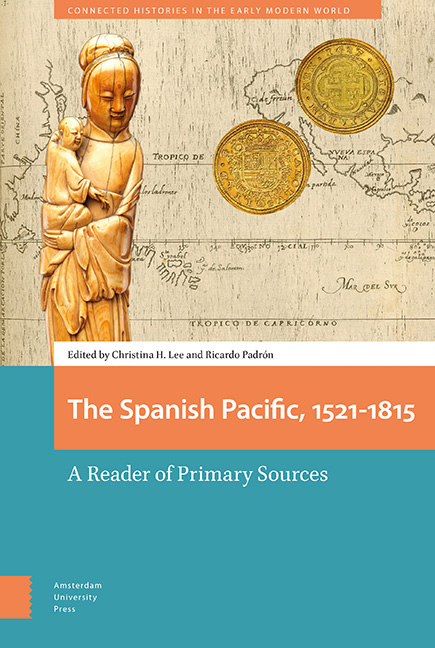Book contents
- Frontmatter
- Contents
- Abbreviations
- Acknowledgements
- Introduction
- 1 An Early Transpacific Account of the Spice Islands by Andrés de Urdaneta (1536)
- 2 Domingo de Salazar’s Letter to the King of Spain in Defense of the Indians and the Chinese of the Philippine Islands (1582)
- 3 Juan Cobo’s Map of the Pacific World (1593)
- 4 A Royal Decree of Philip III Regulating Trade between the Philippines and New Spain (1604)
- 5 Manila’s Sangleys and a Chinese Wedding (1625)
- 6 Don Luis Castilla Offers to Sell Land in Manila (1629)
- 7 Idolatry and Apostasy in the 1633 Jesuit Annual Letter
- 8 The Will of an Indian Oriental and her Chinos in Peru (1644
- 9 Francisco de Combés’s History of Mindanao and Jolo (1667)
- 10 Between Fiction and History in the Spanish Pacific The Misfortunes of Alonso Ramírez (1690)
- 11 A Moluccan Crypto-Muslim before the Transpacific Inquisition (1623–1645)
- 12 Constitutions and Rules of the Beatas Indias (1726)
- 13 The Poetics of Praise and the Demands of Confession in the Early Spanish Philippines: Notes and Documents
- 14 The Pacific Theater of the Seven Years’ War in a Latin Poem by an Indigenous Priest, Bartolomé Saguinsín (1766)
- 15 A Prohibition on Digging Up the Bones of the Dead (1813)
- Index
4 - A Royal Decree of Philip III Regulating Trade between the Philippines and New Spain (1604)
Published online by Cambridge University Press: 20 November 2020
- Frontmatter
- Contents
- Abbreviations
- Acknowledgements
- Introduction
- 1 An Early Transpacific Account of the Spice Islands by Andrés de Urdaneta (1536)
- 2 Domingo de Salazar’s Letter to the King of Spain in Defense of the Indians and the Chinese of the Philippine Islands (1582)
- 3 Juan Cobo’s Map of the Pacific World (1593)
- 4 A Royal Decree of Philip III Regulating Trade between the Philippines and New Spain (1604)
- 5 Manila’s Sangleys and a Chinese Wedding (1625)
- 6 Don Luis Castilla Offers to Sell Land in Manila (1629)
- 7 Idolatry and Apostasy in the 1633 Jesuit Annual Letter
- 8 The Will of an Indian Oriental and her Chinos in Peru (1644
- 9 Francisco de Combés’s History of Mindanao and Jolo (1667)
- 10 Between Fiction and History in the Spanish Pacific The Misfortunes of Alonso Ramírez (1690)
- 11 A Moluccan Crypto-Muslim before the Transpacific Inquisition (1623–1645)
- 12 Constitutions and Rules of the Beatas Indias (1726)
- 13 The Poetics of Praise and the Demands of Confession in the Early Spanish Philippines: Notes and Documents
- 14 The Pacific Theater of the Seven Years’ War in a Latin Poem by an Indigenous Priest, Bartolomé Saguinsín (1766)
- 15 A Prohibition on Digging Up the Bones of the Dead (1813)
- Index
Summary
Abstract
This decree represents one of the earliest attempts made by the Spanish crown to regulate the transpacific trade between Acapulco and Manila. In reaction to complaints that transpacific commerce was harmful to Spain and its Atlantic possessions, the crown attempted to regulate such matters as the number and tonnage of the galleons, the penalties for transporting contraband, the salary of galleon commanders, the manner in which accounts would be kept, procedures for inspecting ships and cargo, and much else. Natalie Cobo and Tatiana Seijas place the document in the context of early modern Spanish mercantilism, intra-imperial commercial rivalries, and the reactive patterns of imperial governance.
Keywords: Manila galleons; early modern trade; mercantilism; colonial Legislation
The Manila Galleon was a royal fleet that sailed between Manila and Acapulco from the late 1560s to 1815 to sustain the Spanish government in the Philippine islands with people and funds and to facilitate trade. The excellent harbor conditions of Manila Bay and its geographic location made it a focal point for exchange, where merchants converged with spices, textiles, ceramics, and other goods from China, Japan, India, and other parts of Asia. The ships of the Galleon transported these commodities, including slaves, to the Americas. On their return, the ships primarily carried minted silver and products like cochineal.
The Hapsburg Crown moved to regulate this fleet in 1593, with additional decrees that were codified in the Laws of the Indies. The 1604 decree by Philip III is one of these documents (Fig. 4.1). Merchants initially carried out trade freely, including by chartering their own ships. The lack of regulation sparked protests from various quarters, from competing merchants in Seville to government officials concerned with the safety and regularity of the ships. The Crown set out the conditions detailed in this decree to address their concerns. The decision to administer and fund an annual fleet had the primary purpose of encouraging vassals to live in Spain's most far-flung settlement in return for trading opportunities. Its chief outcome was to enrich silver merchants in Mexico City, who sent large amounts of capital to Manila to invest in Asian goods, which were then sold back in New Spain (Mexico) for extravagant profits.
- Type
- Chapter
- Information
- Spanish Pacific, 1521–1815A Reader of Primary Sources, pp. 61 - 72Publisher: Amsterdam University PressPrint publication year: 2020



